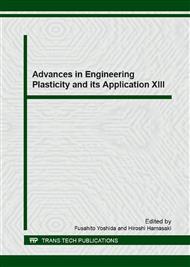p.94
p.99
p.105
p.110
p.116
p.122
p.127
p.132
p.138
Probing Temperature-Dependent Viscoelastic Properties of Glassy Materials Using Impact Induced Vibration - Theory and Experiments
Abstract:
The viscoelastic properties of glass under different temperature are essential for the high-precision thermo-plastic-forming of glass. But it is exceptionally difficult to establish a quantitative relation between the thermal history and the viscoelasticity owing to the lack of constitutive model of glassy materials’ relaxation. The present work investigates the validity of Young’s modulus measurement in impulse excitation technology and then the viscosity predicted by Kelvin and Maxwell model. It is demonstrated that the classical Kelvin model, leads to the seemingly unphysical result that viscosity increases with temperature since the experimental loss rate of damped vibration increases with temperature. Although Maxwell model can be employed to explain the positive temperature dependence of loss rate, the magnitude is even smaller than the viscosity at glass transition temperature and is therefore also unreasonable. The further theoretical work suggests the intermediate zone of Kelvin and Maxwell model.
Info:
Periodical:
Pages:
116-121
Citation:
Online since:
December 2016
Authors:
Keywords:
Price:
Сopyright:
© 2017 Trans Tech Publications Ltd. All Rights Reserved
Share:
Citation:


